|
Ever seen a
towboat out of the water?
 Me standing in front of 140' x 42' m/v G L FURR
Me standing in front of 140' x 42' m/v G L FURR
 Chief Tom Hunt at stbd kort
Chief Tom Hunt at stbd kort
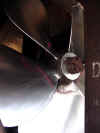 port wheel
port wheel
 port stern
port stern
 port rudders & kort
port rudders & kort
 shaft
shaft
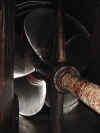 shaft
shaft
 stuffing tube
stuffing tube
 stuffing tube
stuffing tube
 korts
korts
 steering rudder
steering rudder
 flanking rudder bearings
flanking rudder bearings
 tunnel area
tunnel area
 port engine cooler
port engine cooler
 port gear box cooler
port gear box cooler
 Capt. Wallace, he's 6' 1"
Capt. Wallace, he's 6' 1"

 Time elapse photos without tripod. Unusual effect
Time elapse photos without tripod. Unusual effect
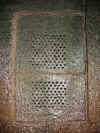 sea chest
sea chest
 stbd coolers, coolers above stair railing are for generators
stbd coolers, coolers above stair railing are for generators
 Notice the strings hanging down from the hull. It is believed these are
the larvae of the Mayfly and if one of these suckers land on your neck,
they can sure bite the heck out of you.
Notice the strings hanging down from the hull. It is believed these are
the larvae of the Mayfly and if one of these suckers land on your neck,
they can sure bite the heck out of you.
 Ever wondered what it looked like just before you got run over by one of
these babies?
Ever wondered what it looked like just before you got run over by one of
these babies?
 SKIN COOLERS
are welded to the sides of the hull. Another type of cooler is a series
of pipes on the bottom of the hull called
KEEL COOLERS.
GRID COOLERS
are like radiators for the engines, gear boxes, and generators placed in
recesses in the hull.
SKIN COOLERS
are welded to the sides of the hull. Another type of cooler is a series
of pipes on the bottom of the hull called
KEEL COOLERS.
GRID COOLERS
are like radiators for the engines, gear boxes, and generators placed in
recesses in the hull.
 Here is the starboard steering rudder,
kort nozzle, and one of the flanking (backing) rudders of a 126' 3600hp
towboat.
Here is the starboard steering rudder,
kort nozzle, and one of the flanking (backing) rudders of a 126' 3600hp
towboat.
Building a
simple frame hull....
"Towboat" Joe's technique
 Here's a basic frame work
for a 1:48 scale
triple screw towboat 200' x 54'. With a hull so large ( 50" x 13 1/2" )
I prefer to do the stern section separate from the main hull. I "break"
it where the deck meets the angle for the raised stern. That is usually
where the tunnel stern starts flattening out for the bottom of the hull.
Notice that the hull side extends 4 1/4" past where I stopped the bottom
sheeting. That is where the flat part of the bottom starts the rise to
the tunnel stern.
Here's a basic frame work
for a 1:48 scale
triple screw towboat 200' x 54'. With a hull so large ( 50" x 13 1/2" )
I prefer to do the stern section separate from the main hull. I "break"
it where the deck meets the angle for the raised stern. That is usually
where the tunnel stern starts flattening out for the bottom of the hull.
Notice that the hull side extends 4 1/4" past where I stopped the bottom
sheeting. That is where the flat part of the bottom starts the rise to
the tunnel stern.
 Here shows the framing of the tunnel stern.
Notice the three tunnel
areas cut into the framing. This will be the end that will be mated to
the main hull. Small sheets will go from here to the flat bottom frame.
Offsetting the joints like this will also make a stronger joint.
Here shows the framing of the tunnel stern.
Notice the three tunnel
areas cut into the framing. This will be the end that will be mated to
the main hull. Small sheets will go from here to the flat bottom frame.
Offsetting the joints like this will also make a stronger joint.
 Here is an overhead view of the tunnel stern bottom
and the port side showing it partially sheeted.
Notice reinforcing angles on
the cross frame to increase strength. Always build framing so that each
sheet will glue together on a supporting frame.
Here is an overhead view of the tunnel stern bottom
and the port side showing it partially sheeted.
Notice reinforcing angles on
the cross frame to increase strength. Always build framing so that each
sheet will glue together on a supporting frame.
 Here are the two parts joined together.
Next
thing is to glue 1/2" blocks into the outside corners. This not only
increases strength, but also gives you wood to sand into when rounding
off the corners. Next I like to glue a 1/4" or 1/2" sheet of Styrofoam
to the bottom with a sheet of 1/4" or thinner plywood on top of that. It
gives me something to screw into if needed plus adds more strength to
the bottom.
Here are the two parts joined together.
Next
thing is to glue 1/2" blocks into the outside corners. This not only
increases strength, but also gives you wood to sand into when rounding
off the corners. Next I like to glue a 1/4" or 1/2" sheet of Styrofoam
to the bottom with a sheet of 1/4" or thinner plywood on top of that. It
gives me something to screw into if needed plus adds more strength to
the bottom.
Another
frame hull can be viewed on the
Bruce Darst page.
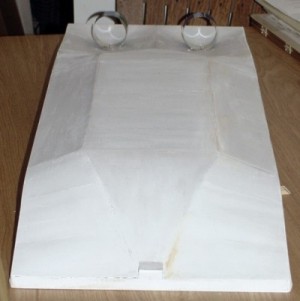 Here's the hull of the
Bruce Darst (a Jeffboat design hull) I carefully mark off the
placement of the steering and backing rudders and I usually install the
sleeves for the rudder struts first thing. Then I measure for the shafts
and drill holes for them. That way I can line up the shafts to figure
the center line placement of the Korts. If I use a can with a seam I
usually epoxy the seam to the hull. It's far less noticeable in that
location.
Here's the hull of the
Bruce Darst (a Jeffboat design hull) I carefully mark off the
placement of the steering and backing rudders and I usually install the
sleeves for the rudder struts first thing. Then I measure for the shafts
and drill holes for them. That way I can line up the shafts to figure
the center line placement of the Korts. If I use a can with a seam I
usually epoxy the seam to the hull. It's far less noticeable in that
location.
Building a
Foam Hull.... "River Bill" Zumwalt's technique
Using the Hot
Wire- Foam Cutting "Bow"
.... this drawing shows how
"Two Templates" from your plans - Side Hull Profile, are made, then
placed - "On Each Side" of the foam block. The templates must be
straight and aligned correctly, meaning directly across from one
another, to insure the hull is cut square. The two - templates, must
also be cut correctly, allowing for the thickness of the coverings of
wood and Fiberglass materials too. This is a must do - task, in order to
keep the model in its correct scale size!
ADJUSTING
THE TEMPLATES
.... By this - I mean, if you chose 1/8" thick balsa sheeting to cover
the foam core hull - for example. Then you must ( Remove ) this same
amount from all 4 sides of the Foam Block, prior to adding the Side
templates Plus you must remove an additional 1/16" off each of the foam,
to allow for the fiberglass & Resin materials, in their thickness - as
well. These two adjustments to both - foam block and templates, insure
the finished hull will be exactly to scale. "So this is critical in
required tasks, before your ready to use the Hot Wire and carve the foam
hull. Once the templates are adjusted, its time to heat up your - HOT
WIRE foam cutter. And Draw the Bow - Gently along the templates - slowly
with a steady pull, to carve away the excess foam....
( SEE NEXT STEP BELOW )
Using the
Hot Wire- "Hand Wand"
....Once the foam Hull Core
- is cut out with the hot wire knife & bow, gently sand the hull core
and check measurements, the block of foam has got to be - Square in
Shape." The next task will be to carve out the "Tunnel Stern" for the
"Wheels" = Props and Rudder systems to be installed later, by changing
to the Small - HAND WAND. REMEMBER, the Tunnel Hull - Stern, must also
be carved out & adjusted in correct depths, to allow for the thickness
of woods & Fiberglass Covering too, since this area will later be
covering too. In this drawing, you can see the "Tunnel Hull" is being
"SPOONED OUT" with the hand wand. Note ... The wand ( Its Wire ), may
want to bend out of shape - as you use it. If it does, your pulling a
bit to hard, so adjust the voltage a bit higher, as needed. "Just don't
get the wire - TO HOT, Noting the hand wand uses a shorter - wire, that
will heat faster, than a longer one!
SPECIAL NOTE.....
Another way to make a Hand Wand, is
to use some heavy "Solid Copper" wire, mounted into an old solder gun.
Shaping the wire to required cutting shapes, then heat it the solder gun
and use it to shape foam objects or sections of the hull!
The
"Thomas K." as the Foam - Hull, was being Built
 The
Deck Plate - awaits the 1/8" balsa sheeting. Bottom, side, Bow & Stern
Plates already installed already, the deck plate - Frame Work, is
completed. Note the area the r/c systems will be installed into, hasn't
covered in wood sheets - yet! The
Deck Plate - awaits the 1/8" balsa sheeting. Bottom, side, Bow & Stern
Plates already installed already, the deck plate - Frame Work, is
completed. Note the area the r/c systems will be installed into, hasn't
covered in wood sheets - yet!
 The
( 6 ) Rudder Sleeve Tubes, are being added to the stern, plus the drive
shafts have been fitted.
Note the area of the r/c
systems, is now also sheeted ( Inner - Rc Bottom Hull Plates ) and all
wood seams have been filled, sanded and sealed/ So the hull is ready for
glass cloth and resin. The
( 6 ) Rudder Sleeve Tubes, are being added to the stern, plus the drive
shafts have been fitted.
Note the area of the r/c
systems, is now also sheeted ( Inner - Rc Bottom Hull Plates ) and all
wood seams have been filled, sanded and sealed/ So the hull is ready for
glass cloth and resin.
 The
deck plate - sheets applied, work continues on the "Rudder Sleeve Tubes"
to seal them and the stern - deck plate.
Sealing the sleeve tubing,
was done with J-B Weld Automotive Epoxy, because 50/50 hobby epoxy will
not withstand moisture for long periods and can come loose! The
deck plate - sheets applied, work continues on the "Rudder Sleeve Tubes"
to seal them and the stern - deck plate.
Sealing the sleeve tubing,
was done with J-B Weld Automotive Epoxy, because 50/50 hobby epoxy will
not withstand moisture for long periods and can come loose!
 The
Kort Nozzles are installed into the stern - Tunnels of the hull
( Note the Port side
- Wheel, or Prop, is already Installed! ) The
Kort Nozzles are installed into the stern - Tunnels of the hull
( Note the Port side
- Wheel, or Prop, is already Installed! )
 The
Thomas K. nearing completion, note its Structures - taking shape, made
of mostly balsa wood, with some plastic's, the structures details
include a fully Detailed - Helm, and All Working Nav. Lights & Radar. The
Thomas K. nearing completion, note its Structures - taking shape, made
of mostly balsa wood, with some plastic's, the structures details
include a fully Detailed - Helm, and All Working Nav. Lights & Radar.
 The
completed 1/48 Scale - 4 channel r/c operated model, after taking
several "St. Louis Admiral Club" Awards. Powered by 12 volt - Gel Cell
Battery, with twin "Homemade Electronic" Speed controls and Twin - Dumas
motors, and prototype Duel - Rudder Steering. Capable of Pushing - over
30+ scale 200' barges, each barge = 50" in length, for a full scale tow,
over 26 feet long - Overall. The
completed 1/48 Scale - 4 channel r/c operated model, after taking
several "St. Louis Admiral Club" Awards. Powered by 12 volt - Gel Cell
Battery, with twin "Homemade Electronic" Speed controls and Twin - Dumas
motors, and prototype Duel - Rudder Steering. Capable of Pushing - over
30+ scale 200' barges, each barge = 50" in length, for a full scale tow,
over 26 feet long - Overall.
Fiber glassing a hull
 I start off by taping the cabins off so spray adhesive won't get on
them. The mat I am using is 3/4 oz fiberglass mat.
Spray adhesive to the hull and lay the mat out,
cutting the contours as needed. After the mat is stuck flat to the hull
with no raised places, it's time for the first coating of resin.
I start off by taping the cabins off so spray adhesive won't get on
them. The mat I am using is 3/4 oz fiberglass mat.
Spray adhesive to the hull and lay the mat out,
cutting the contours as needed. After the mat is stuck flat to the hull
with no raised places, it's time for the first coating of resin.
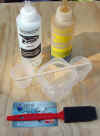 There are two types of resins for this job, Polyester Resin and Epoxy
Resin. I prefer Epoxy Resin because it's virtually odorless and mixes
50/50. For fiber glassing use Finishing Epoxy for it is thinner and
flows better than regular epoxy used for gluing. Polyester Resin is
extremely strong in strength and smell. You have to estimate how many
drops of hardener to add to each ounce of resin according to the
humidity. Humidity affects the setup time of Polyester Resin.
You'll need
two measuring cups, a mixing cup, stirring stick, a disposable paint
brush, razor blade, and a squeegee. Old
credit cards make the best squeegee I've ever found.
There are two types of resins for this job, Polyester Resin and Epoxy
Resin. I prefer Epoxy Resin because it's virtually odorless and mixes
50/50. For fiber glassing use Finishing Epoxy for it is thinner and
flows better than regular epoxy used for gluing. Polyester Resin is
extremely strong in strength and smell. You have to estimate how many
drops of hardener to add to each ounce of resin according to the
humidity. Humidity affects the setup time of Polyester Resin.
You'll need
two measuring cups, a mixing cup, stirring stick, a disposable paint
brush, razor blade, and a squeegee. Old
credit cards make the best squeegee I've ever found.
 Apply the first coat by working the resin
into the matt being sure it soaks the mat
good and adheres to the hull. How do you know that it's enough? Easy!
The mat virtually disappears.
Apply the first coat by working the resin
into the matt being sure it soaks the mat
good and adheres to the hull. How do you know that it's enough? Easy!
The mat virtually disappears.
 After the hull is coated, use the squeegee
to work out any bubbles or creases in the mat.
Always work outward with the grain of the mat. When you've worked it to
where you can see the pattern of the mat, then it's making good contact
to the hull. If you get any creases that won't work out, use a razor
blade to slice it and it will usually flatten out.
After the hull is coated, use the squeegee
to work out any bubbles or creases in the mat.
Always work outward with the grain of the mat. When you've worked it to
where you can see the pattern of the mat, then it's making good contact
to the hull. If you get any creases that won't work out, use a razor
blade to slice it and it will usually flatten out.
 Set the hull aside to dry.
keep an eye on it for the next couple of hours, especially if it's a big
hull with overlapped mat. Sometimes, after it has set for a while, it
may come loose or create a bubble where it has come loose from the hull.
just take the squeegee and lightly rub it back down.
Set the hull aside to dry.
keep an eye on it for the next couple of hours, especially if it's a big
hull with overlapped mat. Sometimes, after it has set for a while, it
may come loose or create a bubble where it has come loose from the hull.
just take the squeegee and lightly rub it back down.
After it has dried, use a sharp
knife to trim of any strings hanging. Next
give it a light sanding and brush on
another coat of resin. I usually apply two
to three coats of resin after the first initial coating with the mat. Be
sure to give it a light sanding between coats. After the second coat the
hull should start looking nice.
Don't try to just coat
a hull with resin and no mat.
Either type of resin will become brittle and crack
easily without the mat. I have found that the one layer of light mat is
sufficient for most hulls. For large heavy hull, you may want to go to a
heavier mat. I buy my mat and Epoxy Resin at
Tower
Hobbies.
Scratch Building Kort Nozzles
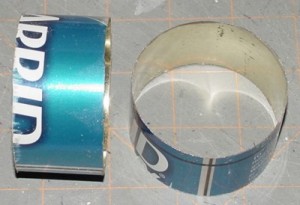 I make Korts out of anything I find that fits
the diameter of the wheel I'm using on the model. I've used everything
from 35mm film canisters to PVC pipe. Here is an anti-perspirant can I
cut up with a moto-tool with a fiberglass cut off wheel. A good way to
mark your diameter is to sit the can on the work table, stack some
blocks and sheets of wood to the cut mark, then hold a sharpie in place
and rotate the can.
I make Korts out of anything I find that fits
the diameter of the wheel I'm using on the model. I've used everything
from 35mm film canisters to PVC pipe. Here is an anti-perspirant can I
cut up with a moto-tool with a fiberglass cut off wheel. A good way to
mark your diameter is to sit the can on the work table, stack some
blocks and sheets of wood to the cut mark, then hold a sharpie in place
and rotate the can.
 Here is a Kort made from a plastic cap from an
aerosol can. Here you can see the shaft support carved from bass wood.
The wheel and rudders are scratch built. I use brass rod for a rudder
shaft and grind it flat on one side to solder the rudder cut from sheet
brass.
Here is a Kort made from a plastic cap from an
aerosol can. Here you can see the shaft support carved from bass wood.
The wheel and rudders are scratch built. I use brass rod for a rudder
shaft and grind it flat on one side to solder the rudder cut from sheet
brass.
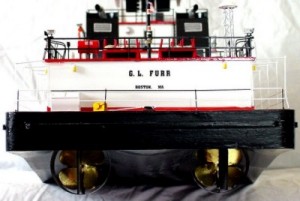 Here's a view of a finished boat. A larger
photo can be viewed on the
G. L. FURR page.
Here's a view of a finished boat. A larger
photo can be viewed on the
G. L. FURR page.
Other views are
Bruce Darst,
Geoffrey, and
Mr. Smitty
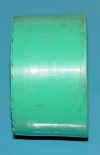 Want a cheap, easy to make kort?
Want a cheap, easy to make kort?
This is the front part of those
cheap $1.00 flashlights that takes two "C" cell batteries. I just took
the lens and bulb reflector out, cut it to the length I wanted, used a
moto-tool with sanding disk to removed the threads inside and there you
go. A 45mm prop fit perfectly inside. I made a couple for my American
Viking.
R/C ADVICE...
If you're building a Kort for an r/c model from a can or plastic that is
flimsy, you should make it stronger by laminating strips of bass wood
around the "Kort" to take the flexibility out of it. You're first choice
may be in plumbing supplies or opting to go the expense of buying a
production Kort from someone like
Harbor Models.
 Here's a photo of a stern showing the Kort
nozzles.
Here's a photo of a stern showing the Kort
nozzles.
|

























 Here's the hull of the
Here's the hull of the 









 I make Korts out of anything I find that fits
the diameter of the wheel I'm using on the model. I've used everything
from 35mm film canisters to PVC pipe. Here is an anti-perspirant can I
cut up with a moto-tool with a fiberglass cut off wheel. A good way to
mark your diameter is to sit the can on the work table, stack some
blocks and sheets of wood to the cut mark, then hold a sharpie in place
and rotate the can.
I make Korts out of anything I find that fits
the diameter of the wheel I'm using on the model. I've used everything
from 35mm film canisters to PVC pipe. Here is an anti-perspirant can I
cut up with a moto-tool with a fiberglass cut off wheel. A good way to
mark your diameter is to sit the can on the work table, stack some
blocks and sheets of wood to the cut mark, then hold a sharpie in place
and rotate the can. Here is a Kort made from a plastic cap from an
aerosol can. Here you can see the shaft support carved from bass wood.
The wheel and rudders are scratch built. I use brass rod for a rudder
shaft and grind it flat on one side to solder the rudder cut from sheet
brass.
Here is a Kort made from a plastic cap from an
aerosol can. Here you can see the shaft support carved from bass wood.
The wheel and rudders are scratch built. I use brass rod for a rudder
shaft and grind it flat on one side to solder the rudder cut from sheet
brass. Here's a view of a finished boat. A larger
photo can be viewed on the
Here's a view of a finished boat. A larger
photo can be viewed on the

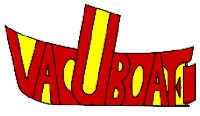 TM
TM